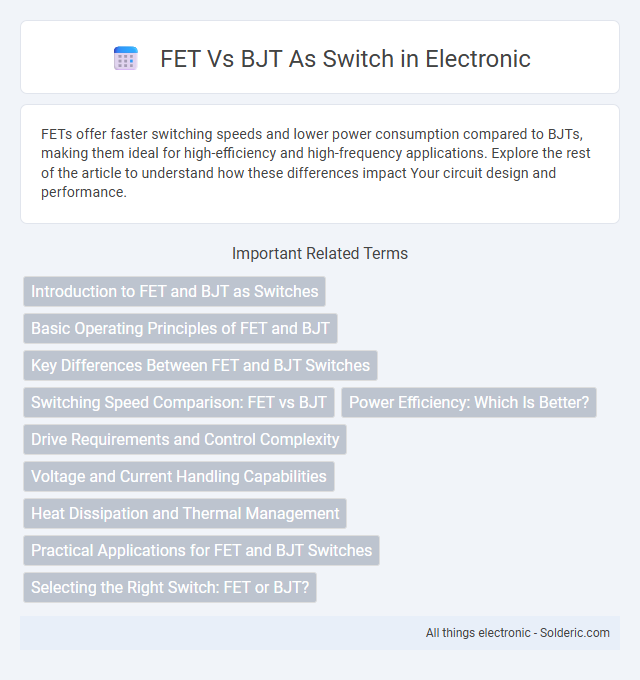FETs offer faster switching speeds and lower power consumption compared to BJTs, making them ideal for high-efficiency and high-frequency applications. Explore the rest of the article to understand how these differences impact Your circuit design and performance.
Comparison Table
| Feature | FET (Field Effect Transistor) | BJT (Bipolar Junction Transistor) |
|---|---|---|
| Control | Voltage-controlled device | Current-controlled device |
| Input Impedance | Very high (typically 10^9 O) | Low (typically 10^2 to 10^3 O) |
| Switching Speed | High speed; suitable for fast switching | Moderate speed; slower than FET |
| Power Consumption | Low gate current; low power loss | Higher base current; more power consumption |
| Thermal Stability | Better thermal stability | Less thermal stability; prone to thermal runaway |
| On-State Resistance / Voltage Drop | Low R_DS(on); lower conduction loss | Higher V_CE(sat); higher conduction loss |
| Drive Requirements | Requires voltage at gate; no continuous current | Requires continuous base current |
| Applications | Digital circuits, power switching, low power control | Amplification, switching in low-frequency applications |
Introduction to FET and BJT as Switches
Field-Effect Transistors (FETs) and Bipolar Junction Transistors (BJTs) serve as fundamental switching devices in electronic circuits, each with distinct operational characteristics. FETs operate by controlling voltage applied to the gate terminal, offering high input impedance and low power consumption, making them ideal for high-speed switching. BJTs function through current control at the base terminal, providing higher gain and faster switching times but with increased power dissipation compared to FETs.
Basic Operating Principles of FET and BJT
Field-Effect Transistors (FETs) operate by controlling current through an electric field applied to the gate terminal, allowing voltage-driven switching with high input impedance and low power consumption. Bipolar Junction Transistors (BJTs) switch by injecting charge carriers into the base region, requiring continuous base current to control the larger collector-emitter current, resulting in current-driven operation. Understanding these fundamental differences helps optimize Your choice between FETs and BJTs for efficient switching applications.
Key Differences Between FET and BJT Switches
FET switches use voltage control to regulate current flow through a high-impedance gate, resulting in lower power consumption and faster switching speeds compared to BJT switches, which rely on current control through the base-emitter junction. You will notice that FETs exhibit better thermal stability and minimal leakage current, making them ideal for low-power and high-frequency applications, while BJTs provide higher current gain and are more suitable for moderate switching with higher drive currents. The intrinsic properties of FETs and BJTs determine their switching efficiency, noise immunity, and overall performance in electronic circuits.
Switching Speed Comparison: FET vs BJT
FETs (Field-Effect Transistors) offer significantly faster switching speeds than BJTs (Bipolar Junction Transistors) due to their majority carrier operation, which reduces charge storage and transition time. This results in lower switching losses and better efficiency in high-frequency applications such as power converters and RF circuits. Your choice of FET over BJT can enhance performance in circuits requiring rapid on-off transitions and minimal delay.
Power Efficiency: Which Is Better?
Field Effect Transistors (FETs) offer superior power efficiency as switches compared to Bipolar Junction Transistors (BJTs) due to their high input impedance and low gate current, which significantly reduces power loss during operation. FETs exhibit lower on-resistance (R_DS(on)) than BJTs' saturation voltage drop, translating directly into less conduction power dissipation when switching loads. This efficiency advantage makes FETs more suitable for high-speed and low-power applications, especially in modern digital and power electronics circuits.
Drive Requirements and Control Complexity
FETs require significantly lower drive current compared to BJTs, making them more efficient for switching applications where minimizing power loss is critical. BJTs need continuous base current to maintain conduction, resulting in higher drive power and more complex control circuitry to manage switching states precisely. Choosing a FET as your switch can simplify drive requirements and reduce overall control complexity while providing faster switching speeds.
Voltage and Current Handling Capabilities
FETs (Field-Effect Transistors) offer higher voltage handling capabilities due to their insulated gate structure, which enables efficient operation at high voltages with minimal gate current. BJTs (Bipolar Junction Transistors) excel in high current handling because they rely on charge injection, allowing you to switch larger currents with proper base drive. When choosing between FET and BJT as a switch, consider that FETs provide better voltage isolation, while BJTs are typically more robust for handling high current loads.
Heat Dissipation and Thermal Management
Field-effect transistors (FETs) generally exhibit lower heat dissipation than bipolar junction transistors (BJTs) due to their higher input impedance and lower on-resistance, which reduces conduction losses during switching. BJTs typically require more complex thermal management solutions because they exhibit higher saturation voltage and therefore generate more heat under load conditions. Efficient heat sinks and thermal interface materials are crucial for BJTs to maintain reliable operation, whereas FETs often allow more compact designs with less intensive cooling requirements.
Practical Applications for FET and BJT Switches
FET switches are widely used in high-speed and low-power applications such as digital circuits, power management in portable devices, and RF amplifiers due to their high input impedance and fast switching capabilities. BJT switches excel in applications requiring high current gain and robustness, commonly found in relay driving, motor control, and audio amplifier circuits because of their ability to handle larger current loads efficiently. Understanding your specific circuit requirements will help determine whether the low power consumption of FETs or the high current capacity of BJTs is more suitable for your switching needs.
Selecting the Right Switch: FET or BJT?
Selecting the right switch between FET and BJT depends on your application's voltage, current, and switching speed requirements. FETs offer high input impedance and faster switching, making them ideal for low-power, high-frequency circuits, while BJTs provide better current handling and robustness for switching larger loads. Evaluate your circuit's efficiency needs and control signals to determine whether a FET or BJT is the optimal choice.
FET vs BJT as Switch Infographic

 solderic.com
solderic.com